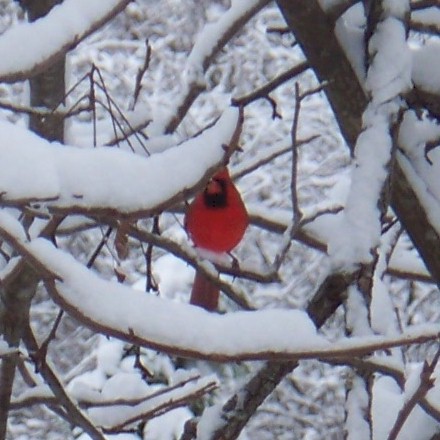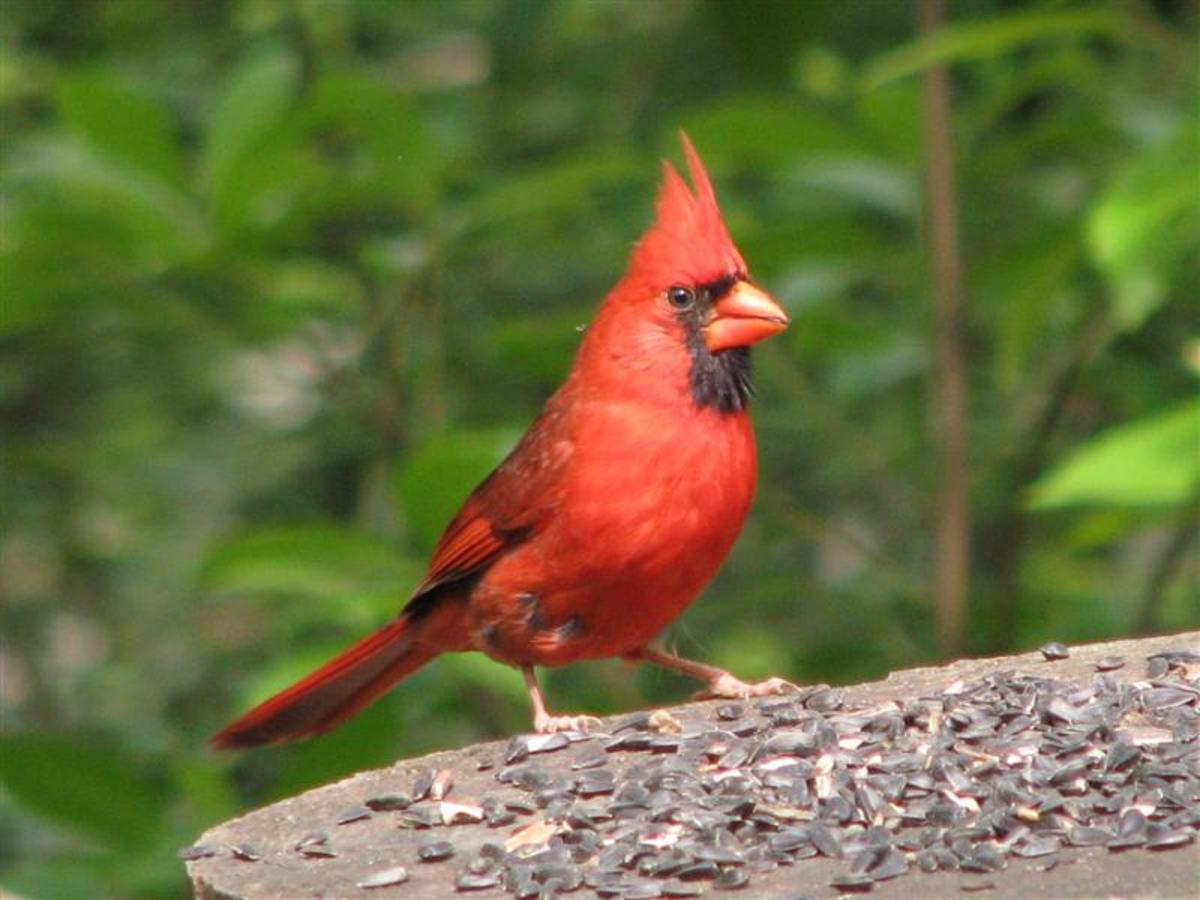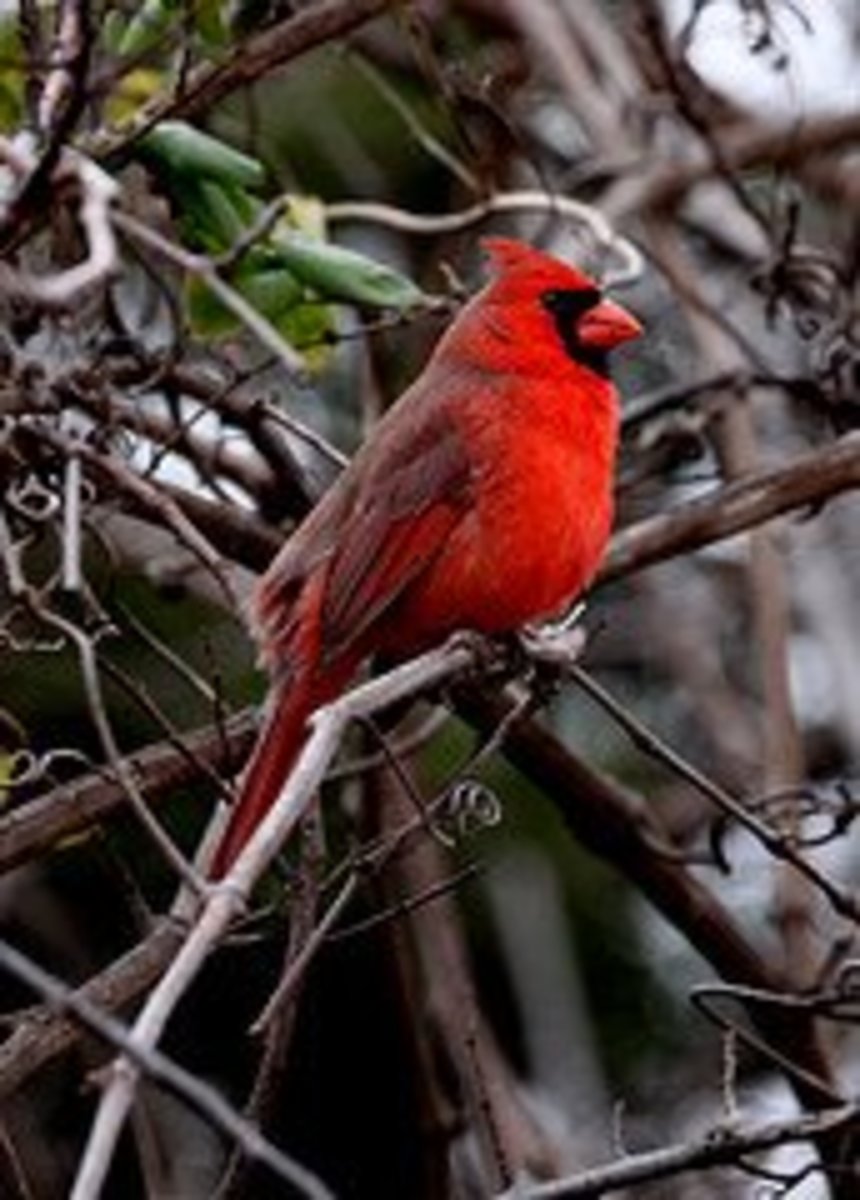Cardinals, Cardinal Sins, Etc.
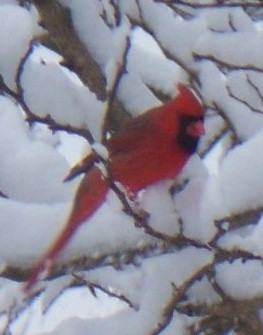
You won’t catch a Cardinal,
Committing a Cardinal sin.
Nope! No matter,
What kind of snit it’s in.

They may swoop in,
And brush another away,
But then it’s a seed or two,
And they’re all ready to play.

I can’t say for sure,
That a Cardinal won’t lust,
But most seem to be,
The kind of bird I would trust.

I can’t see even one,
Being a bit covetous,
You won’t find a Cardinal,
That is gluttonous.

I’ve never seen a Cardinal,
In anger or the least bit mad.
I’ve not seen one too proud,
And I’ve never seen one sad.

Though none are employed,
I would describe none as lazy,
However, I may have,
Seen one that was crazy.

However, I’ve heard your nest,
Can be an untidy affair,
Built of weed stems, grass,
And maybe, even hair.

But I know how busy,
Both parents can be,
Sharing parental duties,
Can make a lovely family tree.

The male and female,
Both feed their young.
And they both sing a duet,
Like none have ever sung.

The male Cardinal,
Is brightly colored in red,
Drawing the predator from the nest,
To chase his flamboyance instead.

The female is a beautiful brown,
With streaks of red on her back.
She’s divinely attractive,
To drive that red male whack.

For these Cardinals,
Are pretty prolific,
And I must insist,
They are terrific!

How I love your,
Large stout bill.
Your lovely music,
Is such a trill!

This “Winter Redbird”,
has such a beautiful song.
How could this tweet bird,
ever do wrong?
~Micky Dee~
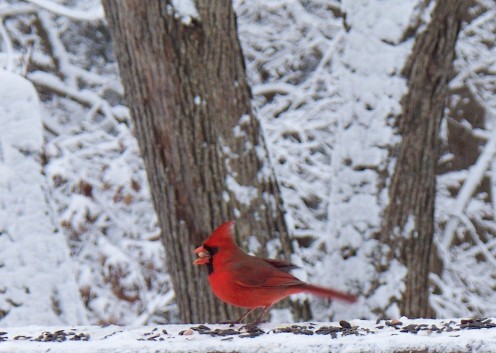
The Cardinal is the state bird and year-round resident of Illinois, Indiana, Kentucky, Ohio, Virginia, West Virginia, and North Carolina.

In the early 1940s, North Carolina found itself lacking an official state bird. Until that time, the mosquito and the “Rockefeller salute” were vying for state bird status. The runner-up was the mourning dove. Alas, it seemed too sad. On March 4, 1943, the cardinal became North Carolina's state bird. On March 5, 1943, absolutely nothing happened.

North Carolina's state bird is the northern cardinal (cardinalis cardinalis). To say that a bird is a cardinal, however, could mean a few things. One is that the bird belongs to the family cardinalidae, as some grosbeaks and buntings do. And a Cardinal should be able to recite at least one Catechism.
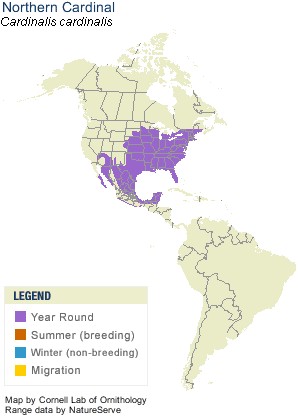
As we can see with the map above, the "Northern Cardinal" is doing well from Canada to Central America and from the Eastern US through the Southwest.
Northern cardinals are abundant but development has diminished some populations. In California, cardinals are native only to the Colorado River Valley, where they are now threatened by loss of habitat.
North Carolina's official bird isn't as common in the state as it once was. While not endangered, the population seems to be on the decrease, with a reduction of about 20 percent in the last 40 years, according to the National Audubon society. Suburban sprawl, which diminishes nesting and foraging possibilities, may be the reason.

St. Louis is home to a migratory species common only to St. Louis and is aptly named the "St. Louis Cardinal". The St. Louis Cardinal is most visible in the summer months.

Another species closely akin to the St. Louis Cardinal is the Arizona Cardinal. These birds are mostly fall and winter birds.

Another Cardinal with extraordinary plumage is the Roman Catholic Cardinal. This bird is most visible in Vatican City, Rome.
Christmas Cardinals
The video above is my first experiment at assembling music with video using a new program. I'm pleased with the way the "experiment" turned out. The program as all others I've sampled, are time consuming and user unfriendly. But I may just not have a handle on it.
The video shows the deck and railing on the rear of my home. I put out mostly sunflower seeds all year 'round and at any time there could be fifty Cardinals waiting their turn at swooping down for a snack. The Cardinals seem to be more prominent with colder temperatures. Birds need more food in winter to stay warm.
But the "Winter Redbirds" dot the white snow and the green trees so beautifully!

· Official North Carolina State Bird Name: Cardinal
· American Ornithologists' Union Common Name: Northern Cardinal
· Also Known As: Red Bird, Winter Redbird
· Family: Cardinalidae, Cardinals
· Scientific name: Cardinalis cardinalis
· Length: 8.75" (22 cm)
· Diet: Seeds & fruit, insects. Only sunflower seeds at Micky Dee's house.
· Voice: Song- a series of high, clear, sharp, mostly slurred whistles woit woit woit woit chew chew chew chew chew or pichew pichew tiw tiw tiw tiw tiw; many variations. Call a high, hard tik; also a softer, rising twik.
· Habitat: Woodland edges, thickets, suburban gardens, towns, swamps.
· Displays: Male and female with outstretched necks and erect crests sway bodies from side to side while singing softly.
· Number of broods: 2, 3, in the southern states, 4 broods are common further north. I guess the colder northern weather just keeps Cardinals "together".
· Nest: In bramble thickets or tree saplings, 1-15' above ground; compact and well lined to flimsy and scarcely lined; of weed stems, pliable twigs, bark strips, grass rootlets, with leaves and paper interwoven, lined with fine grass, hair.
· Eggs: Averages 3-4 grayish-, bluish-, greenish-white eggs, marked with browns, grays, purples. 1.0" (25 mm).
· Incubation period: 12-13 days
· Fledge: 9-10 days after hatching
· Longevity Record: 15 Years and 9 months (according to USGS Bird Banding Lab)

UN-Cool fact: In the 1800s Cardinals were much-sought-after cage birds highly valued for their color and song. Thousands were trapped in the south in the winter and sent to northern markets, and thousands more were sent to Europe. This trade ceased, fortunately, with the passage of the Migratory Bird Treaty Act of 1918.
Sounds like a Cardinal Sin!
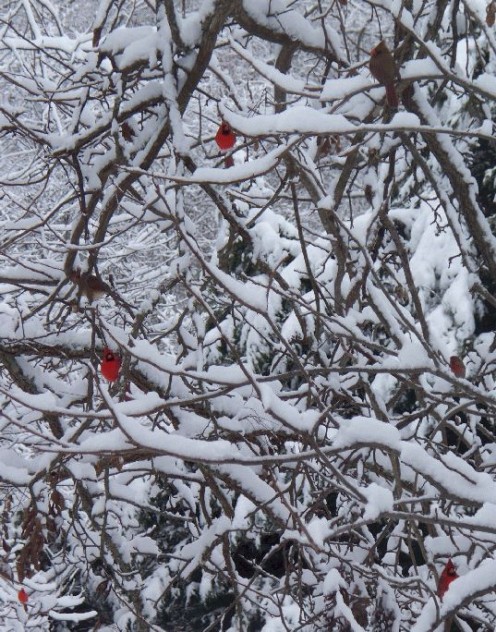
The Cardinal Sins - The Seven Deadly Sins
The "Cardinal Sins or the Seven Deadly Sins" were grouped together as early as the 6th century by Pope Gregory. A sin was classified as deadly not merely because it was a serious offense, morally, but because it gives rise to other sins.
(1) vainglory, or pride
(2) covetousness
(3) lust, understood as inordinate or illicit sexual desire
(4) envy
(5) gluttony, which usually included drunkenness
(6) anger
(7) sloth
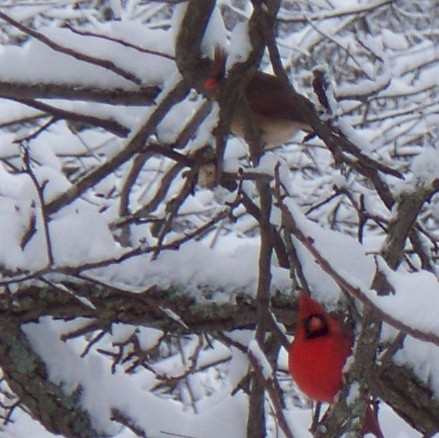
superbia, avaritia, luxuria, invidia, gula, ira, acedia
Gula (gluttony)
is derived from the Latin gluttire, meaning to gulp down or swallow, gluttony (Latin, gula) is the over-indulgence and over-consumption of anything to the point of waste. In the Christian religions, it is considered a sin because of the excessive desire for food or its withholding from the needy.
Thomas Aquinas went so far as to prepare a list of six ways to commit gluttony, including: Praepropere - eating too soon. Laute - eating too expensively. Nimis - eating too much. Ardenter - eating too eagerly (burningly). Studiose - eating too daintily (keenly). Forente - eating wildly (boringly).
Fornicatio (fornication, lust or lechery (carnal "luxuria")
is usually thought of as excessive thoughts or desires of a sexual nature. Aristotle's criterion was excessive love of others, which therefore rendered love and devotion to God as secondary.
Avaritia (avarice/greed)
is, like lust and gluttony, a sin of excess. However, greed (as seen by the church) is applied to a very excessive or rapacious desire and pursuit of wealth, status, and power. St. Thomas Aquinas wrote that greed was "a sin against God, just as all mortal sins, in as much as man condemns things eternal for the sake of temporal things. As defined outside of Christian writings, greed is an inordinate desire to acquire or possess more than one needs or deserves, especially with respect to material wealth.
Like greed, Envy invidia) may be characterized by an insatiable desire; they differ, however, for two main reasons: First, greed is largely associated with material goods, whereas envy may apply more generally. Second, those who commit the sin of envy resent that another person has something they perceive themselves as lacking, and wish the other person to be deprived of it.
Tristitia (sorrow/despair)
is the precipitating cause of suicide. Feelings of hopelessness, despondency, pessimism and impending doom, were not the same as the condition, melancholy. "If the man be bereft, give him solace. If he be in physical torment, give him medicine. If he be to the desire of death, give him hope. Reason, encouragement, and faith bring hope, therefore, use them liberally." -St. Francis of Assisi. Since sadness often results in acedia, Pope Gregory's revision of the list subsumed Despair into Acedia.
Ira (wrath)
is also known as anger or "rage". It may be described as inordinate and uncontrolled feelings of hatred and anger. Anger, in its purest form, presents with self-destructiveness, violence, and hate that may provoke feuds that can go on for centuries. Anger may persist long after the person who did another a grievous wrong is dead. Feelings of anger can manifest in different ways, including impatience, revenge, and vigilantism.
Wrath is the only sin not necessarily associated with selfishness or self-interest (although one can of course be wrathful for selfish reasons, such as jealousy, closely related to the sin of envy). Vengeance is "love of justice perverted to revenge and spite", Dante. In its original form, the sin of wrath also encompassed anger pointed internally rather than externally. Thus suicide was deemed as the ultimate, albeit tragic, expression of wrath directed inwardly, a final rejection of God's gifts.
Acedia (acedia)
has come to be closer in meaning to sloth (Latin, Socordia). The focus came to be on the consequences of acedia rather than the cause, and so, by the 17th century, the exact deadly sin referred to was believed to be the failure to utilize one's talents and gifts. Acedia is the neglect to take care of something that one should do. It is translated to apathetic listlessness; depression without joy. It is similar to melancholy, although acedia describes the behaviour, while melancholy suggests the emotion producing it. In early Christian thought, the lack of joy was regarded as a wilful refusal to enjoy the goodness of God and the world God created. By contrast, apathy was considered a refusal to help others in time of need.
Superbia (hubris, pride) - Vanagloria (vainglory)
In almost every list pride (superbia, or hubris), is considered the original and most serious of the seven deadly sins, and the source of the others. It is identified as a desire to be more important or attractive than others, failing to acknowledge the good work of others, and excessive love of self (especially holding self out of proper position toward God).
Vainglory (vanagloria) is unjustified boasting. Pope Gregory viewed it as a form of pride, so he folded vainglory into pride for his listing of sins. The Latin term gloria roughly means boasting, although its English cognate - glory - has come to have an exclusively positive meaning; historically, vain roughly meant futile, but by the 14th century had come to have the strong narcissistic undertones, of irrelevant accuracy, that it retains today. As a result of these semantic changes, vainglory has become a rarely used word in itself, and is now commonly interpreted as referring to vanity (in its modern narcissistic sense).
In addition to these "SEVEN" several more could be added that we could deem more dire than a few of the Deadly Seven-
Cruelty and dishonesty are bad habits with which our politicians are very familiar.
Fear and superstition can account for more transgressions.
Unwavering Loyalty to political parties is in total disagreement with God.
To parallel and coincide, the seven holy virtues are:
humility,
charity,
kindness,
patience,
chastity,
temperance,
diligence.

But,
if we truly possess love, we should have all the virtues.
We could add the Ten Commandments to the Heavy Deadly Seven Cardinal Sins.
We could write a bill of rights.
We could draw up a constitution.
But if we hold the Golden Rule dear, won't we eschew sin?
There are many virtues to mull and hold dear but none will encompass what the Golden Rule will.
Let's love our mates. If we want the best for our neighbor, we will want the best for our mates. There won't be adultry.
Let's obey the Golden Rule with "not stealing". We don't want another person's stuff and we want them to do well.
And so on and so on.
And we'll try to love those who do not know the Golden Rule.
The Golden Rule is the crossroads where all religions meet.
Yes, even Atheists can participate.
All religions must come together to defeat the evil that grips this Earth.
Humanity needs to stick TOGETHER!
~MD~
